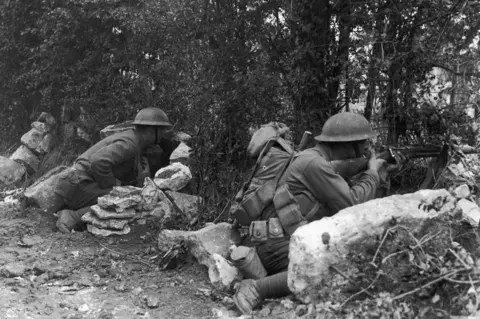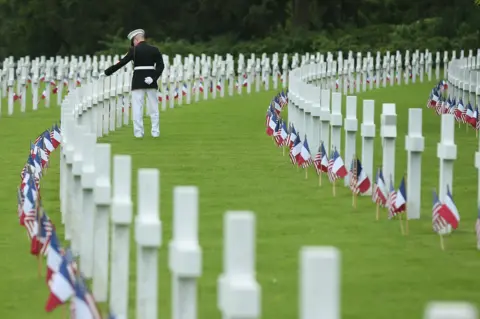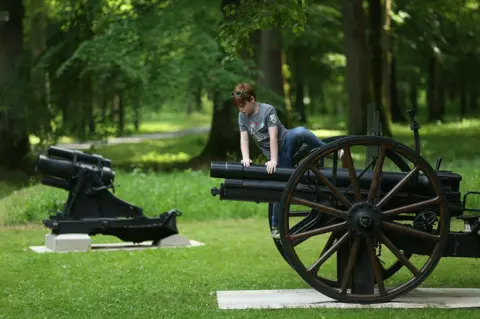Belleau Wood: Why this WWI battle is still important in US
 Getty Images
Getty ImagesAs its 100th anniversary approaches, Patrick Gregory looks at what happened in the World War I battle of Belleau Wood and asks why it occupies such a special place in American military history.
In late April, a photo opportunity featuring Emmanuel Macron, Donald Trump and their respective wives planting a sapling on the White House lawn was beamed around the world.
After the cameras had left, and the picture and visit aside, what attracted more publicity was the subsequent "revelation" that the young tree in question had been removed soon after the slightly awkward ceremony, taken into temporary quarantine.
What achieved less attention at the time was where the sapling had come from and why - a small wood 50 miles from Paris, the Bois de Belleau in France's Aisne department.
Belleau Wood - a bloody encounter of WW1 - occupies a special place in the annals of American military history, an early and vital display of American capability on the battlefield.
As with most such scenes of slaughter of the First World War, it is the only the battle monuments and graveyard that give any clue as to what happened 100 years ago.
Set amidst small villages and farmland 50-odd miles north-east of Paris, Belleau Wood is as quiet now as it doubtless was before the fighting erupted there in June 1918. And that fighting was brutal.
I was in France recently, accompanying a party of American military history enthusiasts who were tracing sites of 1918's key battles in the run-up to this year's Armistice centenary.
 Getty Images
Getty ImagesI was struck, as I had been before, not only by how knowledgeable groups like these were about the whole range of World War I's battles, but also by how keen they were to visit all sites irrespective of the Allied nations involved.
American battlefields yes, but also ones associated with British, French, Canadian, Australian or New Zealand troops.
But for two of the party in particular, ex-Marines and Vietnam veterans, business was still business. All the stops on the way - including to American battlefields - were but a prelude to the site of Belleau Wood near the river Marne.
What happened there was an important moment in the development of the US Marine Corps and the Americans' contribution in the war.

You might also like:

By May 1918 the US had been a combatant in the war for over a year; yet its troops, still arriving in France, had thus far played only a supporting role. That was to change.
The American Expeditionary Force commander John Pershing had to date stubbornly resisted Allied efforts to co-opt his men - a regiment here, a regiment there - to add to their own ranks, remaining determined to train and assemble a fully-fledged army of his own.
The moment now arrived for the first US-led offensive of the war. On 28 May 1918, Pershing's trusted First Division, the "Big Red One", attacked at Cantigny in northern France, 20 miles south of Amiens.
The operation proved a success. Of limited strategic value, perhaps, but the three-day battle nonetheless demonstrated that the American troops could fight and acted as a psychological boost for the AEF.
 Getty Images
Getty ImagesHowever, of more immediate concern to the Allies was the new and deadly enemy offensive which had been unleashed 50 miles south-east of them, cutting easily through Allied lines and driving further south towards the river Marne, leaving German forces within striking distance of Paris.
On 30 May two other American divisions, the 2nd & 3rd, were ordered into the area, arriving from different directions east and west. A machine gun battalion of the latter secured the south bank of the Marne at the key bridgehead of Château-Thierry as other of their number began to arrive on the scene.
But the main action of the weeks ahead would lie north-west of the town, involving men of the 2nd Division; in particular, two of their regiments, a brigade of Marines led by Pershing's old chief of staff James Harbord. It would be their efforts to secure a woodland there that would capture headlines, helped in part by the purple prose of journalist Floyd Gibbons.
Belleau Wood was little more than a mile long and half a mile wide, yet it would cost many lives to capture and would be reported across the world.
"It was perhaps a small battle in terms of World War I," says Professor Andrew Wiest of the University of Southern Mississippi. "But it was outsized in historic importance. It was the battle that meant that the US had arrived."
Yet as operations go, as brave and tenacious as the soldiers were, it was poorly planned and badly commanded, certainly in its opening phases.
After adjacent areas were captured, the decision was taken to advance on the wood on the afternoon of 6 June. But little reconnaissance had been carried out as to what to expect when they got there and only scant artillery fire was laid down beforehand.
 Getty Images
Getty ImagesInside, German machine gunners had taken up positions in defensive holes, behind rocky outcrops and shielded by dense undergrowth. Worse, the Marines now advanced towards them in rank formation over the exposed ground outside. They were slaughtered. By nightfall, 222 were dead and over 850 wounded.
Bloodied but focused on the task, they went again the next day. And the one after that. But little headway was being made. An intense artillery barrage now directed followed by yet another assault.
The casualties mounted, but still the German troops dug in. The fighting laboured on for three weeks, and in its final stages, foot by foot, hand to hand, it intensified in savagery.
Guns and grenades gave way to bayonets and "toad-stickers", eight-inch triangular blades set on knuckle-handles, as the Marines slashed their way through the last of their enemy.
As the story goes, German officers, in their battle reports, referred to the Marines as Teufelshunde "Devil Dogs"; and journalist Gibbons also helped, singling out one gunnery sergeant in dispatches as "Devil Dog Dan". Either way, the name and image stuck and went on to become a Marine mascot.
"It was the day the US Marines went from being a small force few people knew about to personifying elite status in the US military," says Andrew Wiest. The corps had roots dating back to the American War of Independence but from Belleau, there developed much of its modern lore and myth.
More significantly, and of strategic importance, their intervention at Belleau and that of their 2nd and 3rd Division colleagues at the time in the surrounding area on the Marne put paid to the German advance, at what was a dangerous moment in the war for the Allies.
The commander of the US First Division Robert Lee Bullard declared after it: "The Marines didn't win the war here. But they saved the Allies from defeat. Had they arrived a few hours later I think that would have been the beginning of the end. France could not have stood the loss of Paris."
Patrick Gregory is co-author with Elizabeth Nurser of An American on the Western Front: The First World War Letters of Arthur Clifford Kimber 1917-18 (The History Press) American on the Western Front & on Twitter @AmericanOnTheWF
